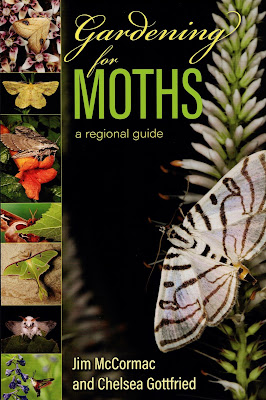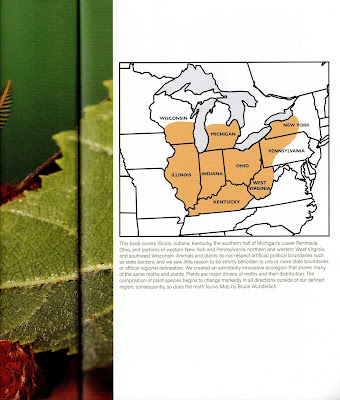I and my coauthor, Chelsea Gottfried, were pleased indeed to receive our first copies of
Gardening for Moths: A Regional Guide, a week or so ago.
Ohio University Press did a magnificent job weaving together lots of text and some 600+ photos. They were a pleasure to work with, and in a first for me, this book actually came out a few months ahead of schedule! I've been waiting until order fulfillment was under way before writing about it here. Books are being shipped pronto and will arrive in short order.
Amazon still lists an arrival date of March 28, but ignore that: they have books in stock and are sending them right along. Books can also be ordered directly from Ohio University Press,
RIGHT HERE.
The book's back cover. We were pleased and flattered to get a nice endorsement from none other than
Doug Tallamy, a man who certainly knows the importance of moths.
As always, click the image to enlarge it
Here's the reason that Gardening for Moths is subtitled
A Regional Guide (please forgive my somewhat crude page scans). As plants drive moths, and plants do not respect arbitrary political boundaries, we saw no reason to be beholden to any one state. The caption under the map explains our rationale for our boundaries.
Gardening for Moths' introduction is quite meaty and documents the importance of this massive group of insects. The darker side of butterflies, moths outnumber their better-known diurnal brethren by perhaps 22 times in the region that we cover. Such an abundant and speciose group would be expected to play an outsized role in Nature, and moths certainly do. They are important plant pollinators, serve as food for legions of other animals, have driven the evolution of certain groups of plants - orchids, perhaps most notably - spawned fantastic mythology, inspired artists, and much more.
The fascinating relationship between moths and bats is one topic that we cover in the intro. The evolutionary arms race between bats and moths is remarkable. Moths are the #1 prey source for bats in our region. Moths do not like getting eaten by the furry aeronauts and have found ways to fight back.
Peppered throughout the book are nearly two dozen inset boxes, like this one on the Sooty-winged Chalcoela, a wasp-eating moth. Intellectual speed bumps of sorts, the inset boxes cover COOL THINGS about moths.
Nearly 150 species of plants are profiled in
Gardening for Moths, most of them ecological heavyweights. In addition to moths, these plants are important to other animals, and we often point out these other beneficiaries as well. In addition to core plant accounts, many other notable native plants are mentioned within accounts as well.
About the same number of moth species as plants are profiled. As with all accounts, plants and moths, there are plenty of accompanying photographs.
Two full pages of "rogue's galleries" of interesting moths can be found near the front and back of the book. Moths are ornate and charismatic insects, and a photographer's dream. They, unfortunately, are not at all well known by most people, especially in comparison to that much smaller faction of the Order Lepidoptera, the butterflies. While myriad books extol the virtues of the latter, we believe
Gardening for Moths is the first book in this country to directly advocate for moths from a conservation gardening perspective.
Please pass the word about
Gardening for Moths, and we would be most pleased - as would the moths (and bats, birds, spiders, fiery searcher beetles etc.) - if you ordered your own copy.
OU Press has a special deal effective through March 8. Enter the code WILD23 in the promo code box at checkout and receive a 30% discount off the list price of $36.95.
Should be available at many booksellers throughout the region covered by the book









1 comment:
Extremely pleased with my copy. Great work, guys!
Post a Comment